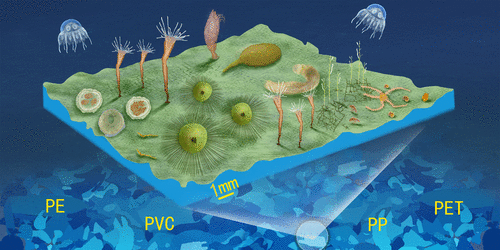当前位置:
X-MOL 学术
›
Environ. Sci. Technol. Lett.
›
论文详情
Our official English website, www.x-mol.net, welcomes your
feedback! (Note: you will need to create a separate account there.)
Large Plastic Debris Dumps: New Biodiversity Hot Spots Emerging on the Deep-Sea Floor
Environmental Science & Technology Letters ( IF 8.9 ) Pub Date : 2021-01-05 , DOI: 10.1021/acs.estlett.0c00967 Xikun Song 1 , Mingxin Lyu 1 , Xiaodi Zhang 2, 3 , Bernhard Ruthensteiner 4 , In-Young Ahn 5 , Guido Pastorino 6 , Yunan Wang 1 , Yifan Gu 1, 7 , Kaiwen Ta 2, 8 , Jie Sun 9 , Xi Liu 10 , Jian Han 9 , Caihuan Ke 1 , Xiaotong Peng 2
Environmental Science & Technology Letters ( IF 8.9 ) Pub Date : 2021-01-05 , DOI: 10.1021/acs.estlett.0c00967 Xikun Song 1 , Mingxin Lyu 1 , Xiaodi Zhang 2, 3 , Bernhard Ruthensteiner 4 , In-Young Ahn 5 , Guido Pastorino 6 , Yunan Wang 1 , Yifan Gu 1, 7 , Kaiwen Ta 2, 8 , Jie Sun 9 , Xi Liu 10 , Jian Han 9 , Caihuan Ke 1 , Xiaotong Peng 2
Affiliation

|
Macroplastic debris recorded in the Mariana Trench and accumulated on some deep-sea canyons worldwide has aroused great public concerns. Large plastic debris dumps found in canyons of the Xisha Trough, South China Sea have become hot spots for deep-sea pollution, with 1 order of magnitude higher abundance than in other investigated canyons. Here we adopted an integrative specimen-based approach to examine macroplastic items from large debris dumps in the Xisha Trough and comparative items from continental shelves with rare macroplastics. On the investigated items, we found an epibenthic ecosystem with relatively high species diversity, comprised of 49 mm-sized fungi and invertebrate species dominated by scyphozoan polyps and brachiopod juveniles according to inhabiting density. These large dumps are functioning as new biodiversity hot spots hosting endemic species like soft corals or aplacophoran molluscs, providing a spawning habitat for gastropods and even specialized parasitic flatworms, and can be inferred as potential scattered regional sources releasing deep-sea coronate jellyfish. We hypothesize that macroplastics can boost population extension of sessile and some free-living (Mollusca) invertebrates and affect the deep-sea benthic-pelagic coupling process. The baseline of associated organisms needs to be set up and monitored in more canyons, where debris is transported to and accumulated at the highest density.
中文翻译:

大型塑料垃圾堆:深海底出现新的生物多样性热点
在马里亚纳海沟中记录并在世界各地一些深海峡谷中积累的大塑性碎片引起了公众的极大关注。在南海西沙海槽峡谷中发现的大型塑料垃圾场已成为深海污染的热点,其丰度比其他调查峡谷高出一个数量级。在这里,我们采用了一种基于标本的综合方法,对西沙海槽大型垃圾场中的大塑性物品和大陆架上稀有的大塑性物品进行比较。在调查项目中,我们发现了一个表皮生态系统,具有较高的物种多样性,根据栖息地密度,该物种由49毫米大小的真菌和无脊椎动物组成,主要由后生虫肉和腕足类幼虫组成。这些大型垃圾场正在充当新的生物多样性热点,容纳诸如软珊瑚或无足章螺软体动物等地方性物种,为腹足类动物甚至特种寄生性扁虫提供了产卵的栖息地,并且可以推断为潜在的分散区域源,释放深海加冕的水母。我们假设,大型塑料可以促进无柄和一些自由生活(软体动物)无脊椎动物的种群扩展,并影响深海底栖-上层耦合过程。需要在更多峡谷中建立和监测相关生物的基线,在该峡谷中,碎片被运送到最高密度并聚集。并可以推断为潜在的分散区域源,释放深海加冕的水母。我们假设,大型塑料可以促进无柄和一些自由生活(软体动物)无脊椎动物的种群扩展,并影响深海底栖-上层耦合过程。需要在更多峡谷中建立和监测相关生物的基线,在该峡谷中,碎片被运送到最高密度并聚集。并可以推断为潜在的分散区域源,释放深海加冕的水母。我们假设,大型塑料可以促进无柄和一些自由生活(软体动物)无脊椎动物的种群扩展,并影响深海底栖-上层耦合过程。需要在更多峡谷中建立和监测相关生物的基线,在该峡谷中,碎片被运送到最高密度并聚集。
更新日期:2021-02-09
中文翻译:

大型塑料垃圾堆:深海底出现新的生物多样性热点
在马里亚纳海沟中记录并在世界各地一些深海峡谷中积累的大塑性碎片引起了公众的极大关注。在南海西沙海槽峡谷中发现的大型塑料垃圾场已成为深海污染的热点,其丰度比其他调查峡谷高出一个数量级。在这里,我们采用了一种基于标本的综合方法,对西沙海槽大型垃圾场中的大塑性物品和大陆架上稀有的大塑性物品进行比较。在调查项目中,我们发现了一个表皮生态系统,具有较高的物种多样性,根据栖息地密度,该物种由49毫米大小的真菌和无脊椎动物组成,主要由后生虫肉和腕足类幼虫组成。这些大型垃圾场正在充当新的生物多样性热点,容纳诸如软珊瑚或无足章螺软体动物等地方性物种,为腹足类动物甚至特种寄生性扁虫提供了产卵的栖息地,并且可以推断为潜在的分散区域源,释放深海加冕的水母。我们假设,大型塑料可以促进无柄和一些自由生活(软体动物)无脊椎动物的种群扩展,并影响深海底栖-上层耦合过程。需要在更多峡谷中建立和监测相关生物的基线,在该峡谷中,碎片被运送到最高密度并聚集。并可以推断为潜在的分散区域源,释放深海加冕的水母。我们假设,大型塑料可以促进无柄和一些自由生活(软体动物)无脊椎动物的种群扩展,并影响深海底栖-上层耦合过程。需要在更多峡谷中建立和监测相关生物的基线,在该峡谷中,碎片被运送到最高密度并聚集。并可以推断为潜在的分散区域源,释放深海加冕的水母。我们假设,大型塑料可以促进无柄和一些自由生活(软体动物)无脊椎动物的种群扩展,并影响深海底栖-上层耦合过程。需要在更多峡谷中建立和监测相关生物的基线,在该峡谷中,碎片被运送到最高密度并聚集。









































 京公网安备 11010802027423号
京公网安备 11010802027423号